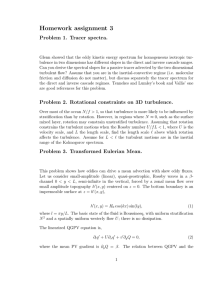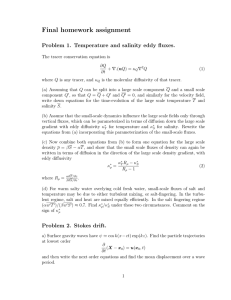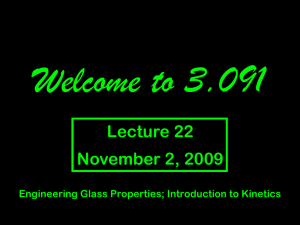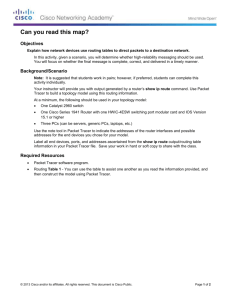Chapter 13 Eddy Diffusivity
advertisement
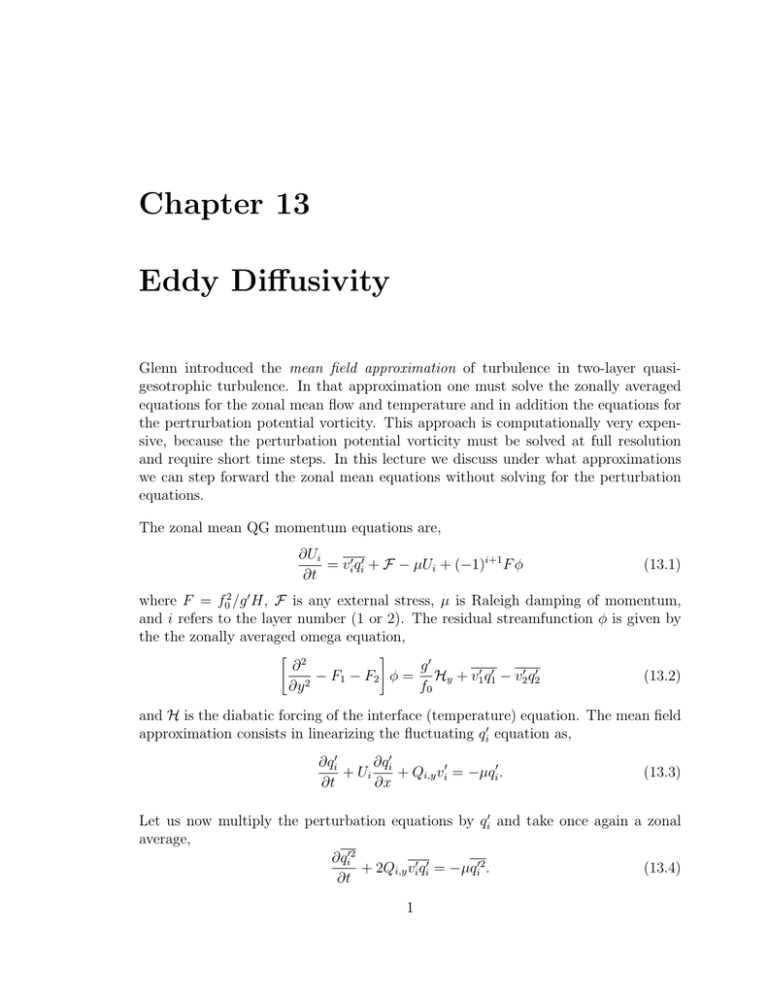
Chapter 13 Eddy Diffusivity Glenn introduced the mean field approximation of turbulence in two-layer quasi­ gesotrophic turbulence. In that approximation one must solve the zonally averaged equations for the zonal mean flow and temperature and in addition the equations for the pertrurbation potential vorticity. This approach is computationally very expen­ sive, because the perturbation potential vorticity must be solved at full resolution and require short time steps. In this lecture we discuss under what approximations we can step forward the zonal mean equations without solving for the perturbation equations. The zonal mean QG momentum equations are, ∂Ui = vi� qi� + F − µUi + (−1)i+1 F φ ∂t (13.1) where F = f02 /g � H, F is any external stress, µ is Raleigh damping of momentum, and i refers to the layer number (1 or 2). The residual streamfunction φ is given by the the zonally averaged omega equation, � ∂2 g� − F − F φ = Hy + v1� q1� − v2� q2� 1 2 ∂y 2 f0 � (13.2) and H is the diabatic forcing of the interface (temperature) equation. The mean field approximation consists in linearizing the fluctuating qi� equation as, ∂qi� ∂q � + Ui i + Qi,y vi� = −µqi� . ∂t ∂x (13.3) Let us now multiply the perturbation equations by qi� and take once again a zonal average, ∂qi�2 + 2Qi,y vi� qi� = −µqi�2 . (13.4) ∂t 1 In a statistically steady state we have, 2Qi,y vi� qi� = −µq �i2 ≤ 0, (13.5) i.e. the QGPV flux in each layer is down its mean gradient. We can therefore write, vi� qi� = −KQi,y , (13.6) where K is a positive definite quantity generally referred to as the eddy diffusivity. If we can specify the eddy diffusivity in terms of zonally averaged quantities, we can use (13.6) to solve the mean field equations. The goal of this lecture is to introduce in a formal way the concept of eddy diffusivity. In the next lecture we will come back to the zonal mean problem for QG turbulence. But in this lecture we will study the relationship between mean tracer concentration and tracer fluxes in general. The tracer will be any concentration c that satisfies the advection-diffusion equation. The QGPV budget is an example of such a tracer. 13.1 Tracer transport We want to study the tracer fluxes generated by a turbulent flow. Our goal is to derive an expression for the eddy fluxes in terms of mean quantities. Consider a generic passive tracer of concentration c, ct + u · �c = κ�2 c, (13.7) where κ is the molecular diffusivity and u is an incompressible (� · u = 0) velocity field. The velocity field is given in this problem, i.e. we do not write a momentum equation to solve for the velocity field. The equation for the mean tracer concentration is, c̄t + ū · �c̄ + � · u� c� = κ�2 c. ¯ (13.8) The fundamental problem of tracer turbulence is to determine the effect of the Reynolds fluxes u� c� on the mean tracer concentration. In order to determine the Reynolds fluxes, we must solve the equation for the tracer fluctuations, � � c�t + ū · �c� + � · u� c� − u� c� − κ�2 c� = −u� · �c. ¯ (13.9) Inspection of eq. (13.9) further suggests that if c� = 0 at t = 0 then, c� and �c̄ are linearly related at all times. The equation for the tracer fluctuations is linear in c� for a prescribed velocity field and it is forced by �c̄: doubling the forcing doubles the tracer fluctuations. In other words we are stating that tracer fluctuations c� are generated by advective distortion of the mean gradient, �c̄. It follows that the eddy flux u� c� is linearly related to the mean gradient �c̄. The coefficient of proportionality between the tracer flux and the mean tracer gradient turns out to be the eddy diffusivity introduced in the previous lecture. 2 13.2 Eddy fluxes and the multi-scale method Using an assumption of scale separation between the turbulent eddies and the mean, we will show how the concept of a tracer diffusivity arises in a Eluerian context. The scale separation approach is based on the assumption that the advected tracer is weakly inhomogeneous on a scale L much greater than the scale l0 of the turbulent fluctuations. The goal is then to derive equations for the evolution of the coarsegrained averaged tracer on the length scale L, and on a time scale T large compared with the time scale t0 ∼ l0 /u0 , characteristic of the energy containing eddies of the turbulence. We may then choose an intermediate scale λ, e.g. λ = (l0 L)1/2 , and an intermediate time τ , e.g. τ = (t0 T )1/2 , satisfying, l0 � λ � L, t0 � τ � T, (13.10) and think of the overbar average as a “local average” over a cube of side λ, and a time of order τ . Averaged quantities will vary only on larger scales of order L and longer times of order T . The replacement of ensemble and volume/time averages is possible only if the turbulence is homogeneous and stationary on the small spatial and temporal scales, so that an ergodic assumptions can be made. The multi-scale method that we use here was first introduced by Papanicolaou and Pirroneau (1981). The scale separation assumption suggests that a perturbation expansion can be done in terms of the small parameter � ≡ l0 /L. Suppose now that c(x, 0) is slowly varying so that, c(x, 0) = C0 (�x). (13.11) Eq. (13.7), together with the initial condition in eq. (13.11) suggests a multiple scale analysis with the slow variables, X = �x, X2 = �2 x, T = �t, T2 = �2 t. (13.12) The solution of eq. (13.7) then takes the form, c(x, t; �) = C0 (X, T ) + � C1 (x, t; X, T ) + �2 C2 (x, t; X, T ) + . . . . (13.13) The quantity of interest is the large-scale, long-time, averaged field c̄ = C0 (X, T ) + O(�). Its evolution is obtained by usual asymptotic methods. Substituting the ex­ pansion (13.13) into the advection diffusion equation (13.7), one obtains a series of equations order by order in �. The advecting velocity field must be expanded as well. We will assume that the velocity field is composed of a mean flow varying on the slow variables only U (X, T ) and a turbulent perturbations u� , u ≡ U (X, T ) + u� (x, t; X, T ). (13.14) We do not assume that the mean flow is of small amplitude compared to the turbulent flow as it is often done in the literature of eddy mean flow interactions 3 13.2.1 Zeroth order solution Let’s write the series of equations order by order in �. At fist order we have, C0t + (U + u� ) · �x C0 − κ�2x C0 = 0. O(�0 ) : (13.15) The solution to this equation, satisfying the assumption that the initial tracer con­ centration is smooth, has the general form, C0 = C0 (X, T, X2 , T2 ). 13.2.2 (13.16) First order solution O(�) : C1t + (u� + U ) · �x C1 − κ�2x C1 = −C0T − (u� + U ) · �X C0 . (13.17) Averaging over the small and fast scales scales, we have, C0T + U · �X C0 = 0, (13.18) from which it follows that, C1t + (u� + U ) · �x C1 − κ�2x C1 = −u� · �X C0 . (13.19) Solutions to this problem can be written in the form C1 = −(ξ · �)C0 + C1 (X, T ), with ξ(x, t) satisfying the equation, ξt + (U + u� ) · �x ξ − κ�2x ξ = u� . (13.20) This equation resembles the equation for a particle displacement, except for the pres­ ence of the molecular diffusive term. This difference is extremely important, because molecular diffusion is ultimately the only process that can mix the tracer. Any theory of diffusion which neglects molecular processes must be taken with suspicion. The terms C1 (X, T ) represents a small correction to the initial tracer concentration. 13.2.3 Second order solution O(�2 ) : C2t + (u� + U ) · �x C2 − κ�2x C2 = −C1T − (u� + U ) · �X C1 + 2κ�x · �X C1 + κ�2X C0 − C0T2 − (U + u� ) · �X2 C1 . 4 (13.21) (13.22) (13.23) By taking the large scale and long time average of this equation, we obtain the solvability condition, C0T2 + U · �X2 C0 + C1T + U · �X C1 = κ�2X C0 + (u� · �X ) ξ · �X C0(13.24) . The rhs represents the diffusion of tracer concentration by molecular and turbulent processes. This is best seen if we write, � κ�2X C0 + (u� · �X ) ξ · �X C0 = �X · κ�X C0 + u� ξ · �X C0 = �X · [D�X C0 ], � (13.25) (13.26) where the tensor D, Dij = κδij + u�i ξj , (13.27) is the effective diffusivity tensor. Summing the solvability conditions at O(�) and O(�2 ) we obtain the evolution equa­ tion for the mean tracer concentration, c̄t + ū · �c̄ = ∂xi [Dij ∂xj c̄]. (13.28) The mean tracer concentration is given by c̄ = C0 + �C1 and derivatives include variations on the slow space and time of first seond order. The effective diffusivity D is obtained by solving eq. (13.20) and computing the correlations between ξ and the velocity fluctuations u� . 13.2.4 Eddy diffusivity The main result of the multiple scale analysis is that there is a relationship between the eddy flux u� c� and the mean tracer gradient �c̄, u�i c� = −Dij ∂xj c. ¯ (13.29) We want to understand what is the meaning of this diffusivity. Let us decompose diffusivity tensor into its symmetric and antisymmetric components, D = Ds + Da , (13.30) where the symmetric component is, s Dij ≡ 1 (Dij + Dji ) , 2 (13.31) 1 (Dij − Dji ) . 2 (13.32) and the antisymmetric component is, a Dij ≡ 5 Using the equation for ξ, u�i ξj = (ξi,t + u�k ξi,k + Uk ξi,k − κξi,kk ) ξj , (13.33) we obtain useful expressions for the diffusive and skew components of the diffusivity, � � 1 1 ∂t (ξi ξj ) + ∂xk (u�k + Uk ) (ξi ξj ) − κ∂xk (ξi ξj ) + κξi,k ξj,k 2 2 � 1 1� = ξj ξi,t − ξi ξj,t + ξj (u�k + Uk ) ξi,k − ξi (u�k + Uk ) ξj,k − κ∂xk (ξi,k ξj − ξj,k ξi ) 2 2 (13.34) s Dij = a Dij The first line is symmetric and represents the diffusive component. The second line is asymmetric and is the skew component. Molecular diffusion contributes a positive definite term to the diffusive component. 13.2.5 Antisymmetric component of the eddy diffusivity The role of the antisymmetric component of the diffusivity tensor is best interpreted if we write D a in the form, a Dij = −�ijk Ψk . (13.35) This is the generic form of an antisymmetric tensor in three dimensions, i.e. any antisymmetric tensor can be written in the form (13.35). The tracer flux associated to the antisymmetric component of the diffusivity is the so called skew flux, a a u� c� = −Dij ∂xj c̄ = �ijk Ψk ∂xj c̄ = Ψ × �c. ¯ (13.36) The skew flux can also be written as, a ¯ � · u� c� = � × (Ψc̄) − (� × Ψ) · �c̄ = � × Ψc̄ + ūS · �c, (13.37) ūS = −� × Ψ. (13.38) where, The skew flux is therefore equal to the sum of a rotational flux and an advective flux. The rotational flux does not affect the tracer evolution, since it has no divergence. The advective component represent the transport of tracer by the Stokes drift ūS . 13.2.6 Symmetric component of the eddy diffusivity Consider the evolution of the variance of the mean tracer concentration, � ¯ S c¯2 + D s �¯ ¯c2 + u ∂t c̄2 + � · u¯ c2 6 � s = −Dij ∂xi c¯ ∂xj c. ¯ (13.39) Changes in tracer variance can be induced by the terms inside the divergence or the term in the rhs. The terms inside the divergence depends both on the antisym­ metric and the symmetric components of the eddy diffusivity. The term on the rhs instead depends on the symmetric component only. The terms inside the divergence represent processes that move tracer variance around the fluid without changing the total integral of the tracer variance. The rhs term, instead, represent a net source of tracer variance. hence only the symmetric component of the eddy diffusivity represent processes that enhance/reduce tracer fluctuations. Let’s compute the term on the rhs of equation (13.39), � � 1 s ∂xi c¯ ∂xj c¯ = − ∂t (ξi ∂xi c) −Dij ¯ 2 − ∂xk (uk + Uk ) (ξi ∂xi c) ¯ 2 − κ∂xk (ξi ∂xi c) ¯ 2 − κ(ξi,k ∂xi c) ¯ 2. 2 Integrating over the fluid volume, we obtain, − � � � dxdydz s Dij ∂xi c¯ ∂xj c¯ = − � � � � dxdydz 1 ∂t (ξi ∂xi c) ¯ 2 + κ(ξi,k ∂xi c) ¯ 2 ≤ 0. 2 � The molecular processes and transience terms that appear in the symmetric com­ ponent of the eddy diffusivity tend to reduce the tracer variance, i.e. they tend to homogenize the mean tracer concentration. 13.2.7 Eddy diffusivity and moments of tracer concentration An alternative approach to understand the effect of the eddy diffusivity on the mean tracer concentration is to compute the evolution of the tracer moments. The first three tracer moments are defined as, M = Mi = Mij = � � � � � � � � � dxdydz c, ¯ (13.40) dxdydz xi c, ¯ (13.41) dxdydz xi xj c. ¯ (13.42) The evolution of the tracer moments is given by, dM = 0, (13.43) dt � � � � � dMi s = dxdydz ūi + ūSi + ∂j Dij c, ¯ (13.44) dt � � � � � � � � dMii s = 2 dxdydz ūi + ūSi + ∂j Dij xi c̄ + 2 dxdydz Diis c. ¯ dt (13.45) 7 Consider a tracer patch with concentration different from zero only in a small area around xi = 0. Then we can approximate the moment evolution as, dM = 0, dt � � dMi s ≈ ūi + ūSi + ∂j Dij M, dt dMii ≈ 2Diis M. dt 13.2.8 (13.46) (13.47) (13.48) Summary about eddy diffusivity In summary then, • The symmetric part of the diffusivity tensor corresponds to something like dif­ fusive transport. • The antisymmetric part, which is almost never zero, and it is in fact usually dominant for rotationally dominated waves, corresponds to an advective trans­ port. As a result, the mean advecting velocity that appears in eq. (13.28) is not ū, but the velocity ū + ūS . This seems to be telling us that the Eulerian mean velocity ū is not the most natural choice of “mean”. 8

